
Looking into some details of how the Penguins played, skated and shot the puck this season
Tooling around on NHL Edge, the league’s player and puck tracking information and came across some interesting data points for the Penguins. Let’s jump right in with a look at where the Pens played at even strength over the course of the 2024-25 season.
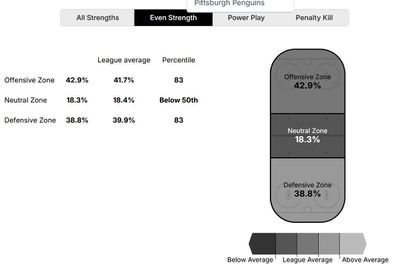
The above chart detailing time in each zone might just show that the Penguins were at least in the right part of the ice most of the time compared to their peers. It’ll be interesting to see how much this changes when not coached by Mike Sullivan, as this outlook at least gives demonstrable data that the team was able to keep the puck in the offensive zone for a good chunk of time — and by default that means not playing in their defensive end.
The big problems this team had were turnovers, quality chances against and subpar goaltending but territoriality they held their own. Might be small consolation but it’s an interesting information to keep in mind as the team moves forward into a new coaching era. One chart doesn’t paint a complete picture of what makes a team good or bad. Can they be successful at this next year with new strategies? Or can they offset any losses in territory by tightening up costly mistakes?
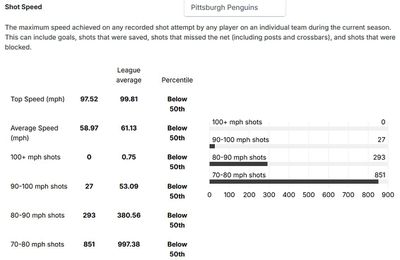
The Pens might need to hit the weight room, adjust their stick flexes or better yet add some stronger players because their shot speeds are downright pathetic relative to the rest of the NHL. You can get around that with well-placed shots or jamming ugly goals in from the front but it’s stood out the team doesn’t have very many players that can blast it. Evgeni Malkin only had one 90+ mph shot all season, back in the day he would launch ‘em. Erik Karlsson provided the team’s fastest shot of the season (97.52 mph) and had 13 out of Pittsburgh’s 27 shots that were recorded at 90+ miles per hour.
Considering NHL average was a team having 53 shots of 90+ mph and the rest of the Pens’ team other than Karlsson only had 14, well, yeah, that’s not very good. Pittsburgh finished 18th in the NHL with 243 total goals, so they still found a way to put the puck in the net to a decent degree but they certainly stand out negatively as a team that doesn’t have very much raw firepower.
Skating-wise, the eye probably told you the Pens weren’t a fast team. The eye wasn’t lying. While Pittsburgh did have some players with some pop, it was limited at 20 miles per hour and not 22mph as much as their competition now boasts. The lack of high-end speed was evident and completely backed up by the data, the Pens didn’t employy any burners this season.
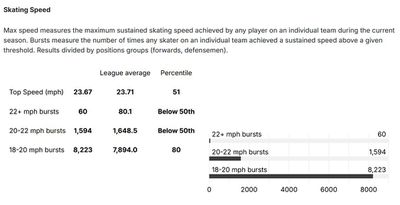
Pittsburgh didn’t have any players show up among the fastest players or quickest bursts this season.
Who were the fastest forwards of 2024-25?
Thanks to the NHL’s tracking data we can find out.
Here are the quickest by top speed and sustained bursts above 20 and 22 miles per hour: pic.twitter.com/l4Pka409gT
— JFresh (@JFreshHockey) April 28, 2025
The Pens did have several of the slowest forwards in the league. Do you know the two biggest offenders? It’s Kevin Hayes and Noel Acciari. Danton Heinen also seems to be losing his burst as well. That’s hardly a surprise, Acciari lived up to the phrase “on his last legs” literally as the season dragged along and he accumulated more and more punishment from his style of play. Hayes’ contract and solid locker-room intangibles are practically the only reason he is in the big leagues these days.
Of course, it’s worth acknowledging that fast doesn’t always mean good and slow doesn’t always mean bad. Their are some “slow” NHL forwards who are among the best players in the league. There are some players who appear on the fast list who aren’t very good at all. It’s all a matter of what one can do with the speed or to overcome the lack of it.
Who were the slowest forwards of 2024-25?
Thanks to the NHL’s tracking data we can find out.
Here are the slowest by top speed and sustained bursts above 18 and 20 miles per hour: pic.twitter.com/iHHAfFgLIJ
— JFresh (@JFreshHockey) April 28, 2025
On the blueline, the Pens did employ one of the fleetest of foot around. Erik Karlsson is getting older, but love him or hate him, he remains an absolutely brilliant skater. (Playing with purpose, drive and consistently keeping it going remains the sticking point there).
Who were the fastest defencemen of 2024-25?
Using the NHL’s tracking data, here are the best top speeds and highest speed burst rates: pic.twitter.com/YwsxHSIdag
— JFresh (@JFreshHockey) April 28, 2025
Pittsburgh doesn’t make many appearances for the slowest defenders, Connor Timmins pops up once for slowest sustained speed.
According to the NHL’s tracking data, which defencemen played the slowest in 2024-25? pic.twitter.com/j8cg5Q4pgi
— JFresh (@JFreshHockey) April 28, 2025
A little more on Karlsson since his data is fascinating. It’s easy to remember the frustrating bad plays where he’s floating in space after turning the puck over — the video from his season has a lot of flaws — but considering he’s 34-years old his ability to motor around the ice really is something incredible. He can turn on the jets, all the ability is there and you can see why GM Kyle Dubas would call him out and challenge this player publicly to pull it together.
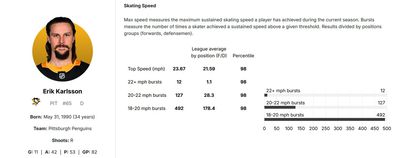
While we’re stirring the pot on polarizing superstars, how about the Evgeni Malkin speed chart? Think we should save these in the player season reviews but we’re all having fun now.
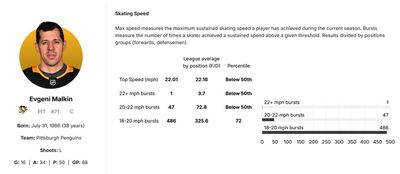
Sadly, it shows that this is a 38-year old’s chart who has had two major knee reconstructions. Would have loved to see NHL Edge around from 2006-11 to see what the galloping Malkin’s data looked like back then in his prime. Possibly the peculiar thing is that Malkin still can get going, but his top gear to top 20 mph isn’t there any longer. He only played 68 games and at an average of 17:47 per game it’s not like his ice time was sky high but he was still able to get going with some burst…Just with a very clear limit of being in 18-20 range.